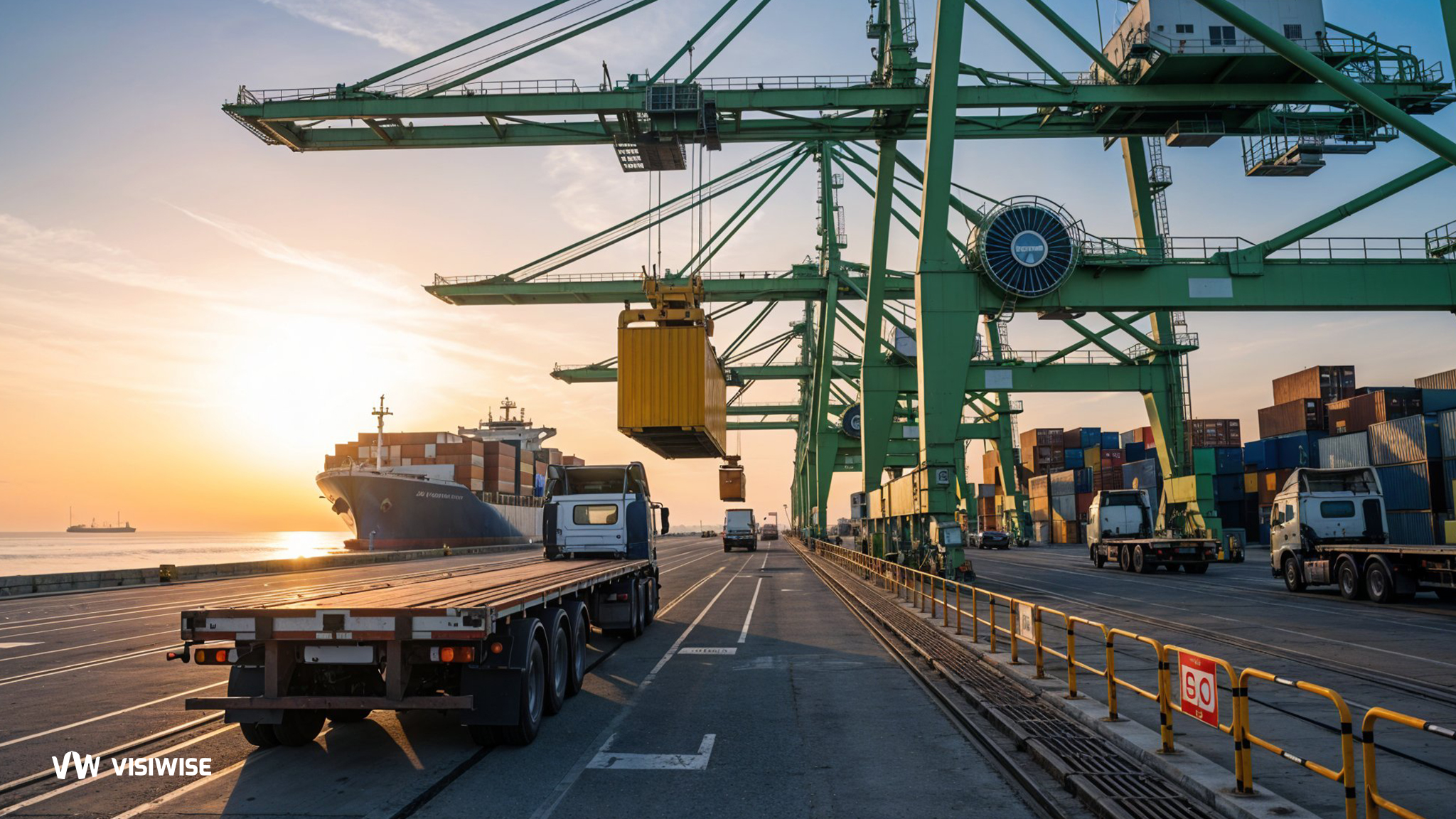Freight shipping is the process of transporting goods in bulk across different locations, often internationally. While many people think it only involves a ship or plane to transport cargo from one country to another, freight shipping actually involves other modes of transportation that contribute as well. It also includes transport by road vehicles, such as trucks, with drayage being a key component.
What is Drayage in Shipping?
Drayage is one of the modes of transport in a typical freight shipping process. It provides the necessary link in the supply chain that spells the success of multimodal transport. If you’re asking “what does drayage mean?”, you’ve come to the right place. In this article, we discuss everything you need to know about container drayage.
Definition: Container Drayage Meaning
A drayage is a form of trucking service that connects the different modes of shipping (intermodal), such as ocean freight or air freight. It’s a short-haul trip that transports goods from one place to another, usually before or after its long-haul shipping process. Drayage trucks move cargo to and from various destinations, such as container ships, storage lots, order fulfillment warehouses, and rail yards.
How Drayage Works
Typically, drayage only transports goods in short distances and operates only in one metropolitan area. It also requires only one trucker in a single shift. But despite this, it plays an important role in long-haul shipping because it gets the goods to the cargo and vice versa. It makes intermodal transport much more efficient and enables the seamless transfer of goods to the end customer.
Historical Background of Drayage
The concept of container drayage has an interesting history that dates back a long time. While contemporary shipping and confining equipment are used, drayage predates the current industrial period and originates with earlier container types.
The term “drayage” was derived from the horse-drawn cart known as a “dray.” Due to the physical limitations of the horses utilized in this operation, distribution was limited to small distances, generally near seaports, railway and waterway terminals. This practice was used throughout the 1800s and into the early 1900s. Then trucks became the primary equipment in this process.
Categories of Drayage Services
There are six types of drayage services identified by the Intermodal Association of America. These include:
- Pier Drayage
The truck picks up the goods from a rail hub and transports them to a pier or dock where they will be loaded onto a ship.
- Intra-Carrier Drayage
This is short-haul, usually used to transport goods within the transport hub. It’s often used when goods are scheduled to board a plane in another dock or must be taken to the container freight station.
- Inter-Carrier Drayage
Inter-carrier drayage refers to the transport of cargo between carriers. This can be from rail-to-rail, rail-to-sea, or sea-to-rail. For example, goods that are dropped off by ships at the docks are carried by drayage trucks to their scheduled railroad transport. This also works vice versa, wherein cargo that has completed its rail transport is brought to the ocean port where it will be sent to voyage.
- Shuttle Drayage
Shuttle drayage is used to temporarily store excess containers that couldn’t fit in docks or shipping hubs. These docks receive various loads a day, but they don’t always have enough ships to carry the cargo. Shuttle drayage keeps these goods safe in storage until the next ship is ready for departure.
- Expedited Drayage
This drayage transfers goods quickly to where they are needed and is often used to transport cargo urgently. Expedited drayage is a faster process and is often used for quick shipping solutions.
- Door-to-Door Drayage
This drayage transports goods from the port directly to the customer’s doorstep. It is often used in e-commerce situations where door-to-door delivery is offered.
Examples of Shipping Containers
Examples of shipping containers include:
- Open top container
- Reefer intermodal carriers
- Flat rack container
- Dry van containers
Why Is Container Drayage So Important?
An estimated 80 percent of all goods are carried by sea and a majority of businesses rely on shipping containers to move their product, especially if they ship internationally. Container drayage is an integral part of the logistics process and when done right, can lead to a timely and cost-effective supply chain.
How Drayage Affects Cost, Time, and Stress
Container drayage can affect how long it takes to get your product and how much it costs. It can also consume your time and leave you stressed. You have to schedule transportation of the container from its starting point to its destination. You may also have to search and find the appropriate containers and chassis.
Paperwork, Fees, and Logistics Challenges
Certain paperwork requirements need to be completed before the movement of the containers. You may also have to pay fees depending on where you’re moving the container to and from. If you want to move products around either from country to country or warehouse to warehouse, you will have to have container drayage services.
Managing Relationships Across the Supply Chain
It can be difficult trying to manage different relationships and agencies when handling your supply chain. You may have to handle a manufacturer, a freight brokerage, a transportation company, a 3PL, and possibly a warehouse. Handling so many contacts just to move a container can be stressful and time-consuming.
Drayage Services and the Cold Chain Expounded
Reefer containers (refrigerated containers) make part of the drayage cold chain. Reefer containers are used to transport perishable freight such as pharmaceuticals, flowers, food, and more.
Importance of Expedited Drayage in the Cold Chain
The cold chain process must remain intact without being broken. The cold chain will rely on expedited drayage as it is time-sensitive.
Cartage vs. Drayage: What’s the Difference?
The phrases cartage and drayage may be used interchangeably. While both often apply to the transportation of products across small distances between intermodal shipping legs, the similarities may end there.
Drayage is the transport of an undamaged cargo box from one location to another. Cartage, on the other hand, entails breaking down the goods into smaller components and carrying them from one location to another.
Intermodal vs. Drayage: Are They the Same?
The growth in intermodal freight shipping is boosting demand for drayage movement. However, despite their interdependence, intermodal and drayage are not the same thing.
Intermodal refers to freight that is transported using more than one method of transportation. When multiple transportation methods are utilized, drayage refers to short-distance operations that link the modes of conveyance
Understanding Drayage Charges
Drayage charges are odd in the sense that during the quoting process, not all charges are known or quoted upfront. When sending out RFQ’s, it’s important to get as many possible charges on the quote as possible—in order to avoid surprises on the invoice.
Common Drayage Charges
Most charges are known or can be estimated beforehand.
Most commonly known drayage charges include:
- line haul rates
- fuel surcharges
- charges specific to the pick-up/drop-off terminal
- chassis positioning, return and rental
- tolls
- refrigerated, bonded, overweight, hazardous, etc.
- congestion fees (wait time at busy ports)
Charges Often Unknown at Quotation Time
Drayage charges which are typically unknown at the time of quotation are demurrage and detention charges. There can be other delivery-specific charges as well.
Tips for Accurate Quoting
It is important to ask the right questions to drayage companies, including freight forwarders and ocean carriers, when collecting quotes. In order to get an accurate cost prediction upfront, the more of these charges that are referenced, the better. Only when all the known charges are listed on all quotations, can you really compare the providers.
Final Thoughts
Drayage connects and links the whole process of container shipping. It contributes to getting your cargo from one place to another and completes the intermodal shipping process through various transportation means. Drayage ensures that your goods are transported where they should be at the right time and allows a more efficient means of moving cargo.



